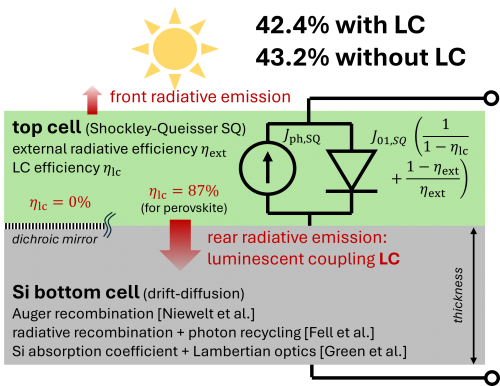Si single-junction and tandem efficiency limits

Oct 02, 2025 Andreas Fell
Theoretical JV performance limits of Si based solar cells
Example 1: single-junction Si limit ("Auger limit")
This example reproduces the latest Auger limit of a single-jcuntion Si solar cell as published by Niewelt et al. (https://doi.org/10.1016/j.solmat.2021.111467). Specifically, it reproduces the thickness-dependence of the efficiency limit for undoped, 1 Ωcm n-type and 1 Ωcm p-type material as given in Fig. 4, see below.

An additional settingsfile is contained which runs in the free version of Quokka3, by neglecting photon-recycling (paid-version feature). This results in a ~0.1%abs efficiency penalty compared to the full model.
Example 2: Tandem cell with Auger-limit Si bottom cell an Shockley-Queisser (SQ) limit top cell
This example simulates the theoretical efficiency limit of a tandem cell with a Si bottom cell using the same state-of-the-art models as in the above single-junction example. For the top cell a detailed-balance / SQ limit is assumed, with step-function absorption at the radiative limit defined by the material's bandgap. The model includes photon recyling (explicitely in the bottom cell, and implicitely in the top cell by the SQ model), and luminescent coupling. Nonradiative recombination can be easily added by setting a non-unity external radiative efficiency of the top cell. See details in Fell et al., EES Solar 2025 (https://doi.org/10.1039/D5EL00085H). The settingsfile reproduces the data in Fig. 2.
